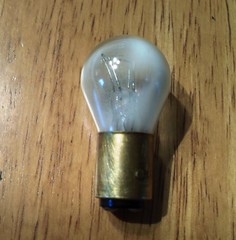When I read http://scootrally.com/phpBB3/viewtopic.php?f=2&t=1738 , I get the impression that they, themselves don't know what's going on. My explanation is still plausible. Right? Don't know.
Follow along with the video below to see how to install our site as a web app on your home screen.
Note: This feature may not be available in some browsers.
The two filiments have different voltage ratings.
When I read http://scootrally.com/phpBB3/viewtopic.php?f=2&t=1738 , I get the impression that they, themselves don't know what's going on. My explanation is still plausible. Right? Don't know.
The Rob Hodges guy seems to know. Apparently he owns a scooter shop, and if you look at his post, he seems to be on top of it.
KISS, your theory is still a viable explanation, because Hodges probably isn't an electronics guy. But he is a scooter guy, so when he says throwing one regulator on the traditional Italian circuit won't be a solution, I've got to respect that.
Your thoughts?

<snip>
The system probably doesn't have a fuse because there's no battery. In the slightly larger model, the Gilera 124 bike, there's a battery w a fuse. For mine, it might be wise to add a fuse to the taillight, since fuses are cheaper than lights. Actually a resettable circuit breaker would be even better, but I don't know if they make one small enough for this system.
the OP said:The blown light was a 6v 5/15w (5w taillight, 15w brake light), although the system really calls for a 3/15w. Do you think the slightly different spec was a reason for it to blow?
Attached is a picture of the blown light. Also attached is the bike's "lighting set" page, and also the full manual in case I'm not giving you all the info.
Kiss, so the brake or taillight acts a ballast resistor to protect the points or coil from getting too much current or voltage? Ok, but why wire in the brake light so that you lose ignition if the light breaks. Does that have a purpose, or is it an accident of the design?]/quote]
It saves a few parts.
Some examples:
The other 6V winding might have to be larger to accommodate another 15 Watts. 15/6 is more than 2 Amps. May or may nor be significant.
Yes; we now have confirmation that the switch is the NC type. It follows that, until the brake is applied, there is no ballast resistor in circuit.When the brake is applied, the ground is broken. Does this help?
It means that as the revs build up the effective resistance (reactance) of the ignition coil increases proportionally and thus compensates for the increasing voltage from the magneto. This stabilises the ignition coil current and protects the ignition coil, but unfortunately not the brake light bulb.Alec, what does this mean to a layman
"Alec, what does this mean to a layman (me): "I don't believe the bulb filament resistance has any significant voltage-regulating effect. What is regulated (approximately) though, is the current through the ignition coil primary, because as the rpm increases the magneto voltage increases but so does the AC frequency and hence the reactances of the primary coil inductance and the magneto coil inductance."
